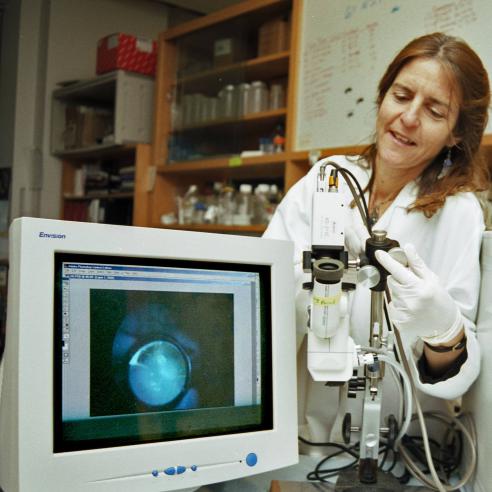RPB researchers are uncovering causes of retinitis pigmentosa and creating new approaches for cures and treatments.
Retinitis Pigmentosa
The term retinitis pigmentosa (RP) refers to a group of hereditary diseases, all of which eventually result in severe vision loss. Some of the diseases in the RP family are Usher syndrome, Lebers congenital amaurosis, rod-cone disease, Bardet-Biedl syndrome, and Refsum disease. Approximately 100,000 people in the U.S. have RP. Symptoms usually surface during adolescence or young adulthood, although some RP diseases are apparent even in infants. RP progresses at different rates in individuals, but most people with RP are legally blind by age 40. Some forms of retinitis pigmentosa are associated with other disabilities, such as deafness in people with Usher syndrome.

"Precursor" photoreceptor cells have been stained green and introduced to the layer of retinal nerve cells (in red) that transmit visual information Photo courtesy of Anand Swaroop, Ph.D.and Masayuki Akimoto, Ph.D., University of Michigan School of Medicine
Scientists have restored vision in mice with retinal degeneration by transplanting stem cells at a specific stage in their development. Restoring vision in humans with RP and macular degeneration through a similar process is still years away, according to the researchers, but human clinical trials have already started.
Watch an ABC News story about the restoration of sight for people with Lebers congenital amaurosis. The researchers in the story (one of three RPB-supported research teams working on this form of gene therapy), have been supported by RPB grants since 1992.
Findings by researchers working with the grant support of Research to Prevent Blindness (RPB) lead to the discovery that RP symptoms are caused by the death of cells in the retina. The retina is a light detecting layer inside the eye that sends visual images to the brain. In most cases of RP, retinal cells called rod photoreceptors are the first to die, followed by cone photoreceptors. Rods are concentrated in the periphery of the retina. They help us see in dim light. Therefore, as the death of rod cells advances, night vision and then peripheral vision progressively disappear. In fact, night blindness is an early symptom of RP. When cones die first, central vision and color vision are impacted before peripheral vision.
Related News: Retinitis Pigmentosa

RPB Accelerates Retinitis Pigmentosa Research with Awards to Leading Scientists
RPB is providing $500,000 to accelerate the development of treatments for Retinitis Pigmentosa (RP) -- a family of retinal diseases that progressively create extreme tunnel vision, loss of night vision and leave...

Gene Therapy Proven Effective for Patients with Inherited Retinal Disease
Researchers have used gene therapy to safely restore vision in three young adults with a form of retinitis pigmentosa known as Leber's congenital amaurosis (LCA), an inherited retinal disorder that reduces...
Subscribe
Get our email updates filled with the latest news from our researchers about preventing vision loss, treating eye disease and even restoring sight. Unsubscribe at any time. Under our privacy policy, we'll never share your contact information with a third party.
| General Info | Research Scientists & Grantees | Eye Care Specialists | Donors & Partners |



